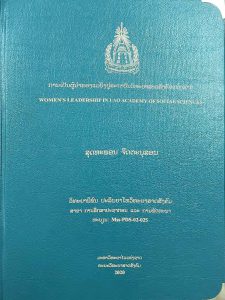ການເປັນຜູ້ນຳຂອງແມ່ຍິງຢູ່ສະຖາບັນວິທະຍາສາດສັງຄົມແຫ່ງຊາດ

ອ່ານວິທະຍານິພົນສະບັບເຕັມ
ຫົວຂໍ້:
ການເປັນຜູ້ນຳຂອງແມ່ຍິງຢູ່ສະຖາບັນວິທະຍາສາດສັງຄົມແຫ່ງຊາດ
Title:
WOMEN'S LEADERSHIP IN in LAO ACADEMY OF SOCIAL SCIENCES
ຜູ້ຂຽນ | Creator:
ສຸທະພອນ ຈິດຕະນຸສອນ | Soudthaphone CHITTANOUSONE
ທະບຽນ | Reg. No:
Mss-PDS-02-025
ປີ | Year
2020
ມະຫາວິທະຍາໄລ | University
ມະຫາວິທະຍາໄລແຫ່ງຊາດລາວ | National University of Laos
ຄະນະວິຊາ | Faculty
ຄະນະວິທະຍາສາດສັງຄົມ | Faculty of Social Science
ປະເທດ | Country
ສປປ ລາວ | Lao PDR
ພາສາ | Language:
ພາສາລາວ | Lao
ລະດັບປະລິນຍາ | Degree:
ປະລິນຍາໂທ | Master Degree
ສຳນັກພິມ | Publisher:
............... | .....................
ບົດຄັດຫຍໍ້ ບົດຄັດຫຍໍ້
Abstract Abstract
ບົດຄົ້ນຄວ້າມີ 3 ຈຸດປະສົງຄື: 1) ສຶກສາສະພາບການເປັນຜູ້ນໍາຂອງແມ່ຍິງ; 2) ສຶກສາປັດໄຈສະໜັບສະໜູນ, ບັນຫາກີດຂວາງການເປັນຜູ້ນໍາຂອງແມ່ຍິງ ແລະ 3) ສຶກສາແນວທາງສົ່ງເສີມແມ່ຍິງ ເປັນຜູ້ນໍາຢູ່ສະຖາບັນວິທະຍາສາດສັງຄົມແຫ່ງຊາດ. ປະຊາກອນແມ່ນພະນັກງານຢູ່ສະຖາບັນວິທະຍາ ສາດສັງຄົມແຫ່ງຊາດທັງເພດຍິງ ແລະ ເພດຊາຍ. ກຸ່ມເປົ້າໝາຍແມ່ນພະນັກງານນໍາພາຂັ້ນກົມ ແລະ ຂັ້ນພະແນກ ລວມທັງໝົດ 23 ທ່ານ ໂດຍນໍາໃຊ້ວິທີການສຶກສາແບບຄຸນນະພາບ. ເຄື່ອງມືໃນການ ເກັບກຳຂໍ້ມູນແມ່ນເອກະສານກ່ຽວຂ້ອງເຖິງສະຖາບັນວິທະຍາສາດສັງຄົມແຫ່ງຊາດ ແລະ ແບບສໍາພາດ. ການວິເຄາະຂໍ້ມູນແມ່ນວິເຄາະເນື້ອໃນທີ່ໄດ້ຈັດເປັນໝວດໝູ່ໄວ້. ໂດຍໄດ້ນໍາໃຊ້ແນວຄວາມຄິດ, ທິດ ສະດີ, ນິຕິກຳ ແລະ ການສຶກສາທີ່ກ່ຽວຂ້ອງເປັນແນວທາງໃນການວິເຄາະ ແລະ ແປຜົນ.
ຜົນການສຶກສາເຫັນວ່າ: ການປະຕິບັດສິດສະເໝີພາບຍິງ-ຊາຍ ຢູ່ສະຖາບັນວິທະຍາສາດສັງຄົມ ແຫ່ງຊາດໃນໄລຍະ 10 ປີ ທີ່ຜ່ານມາ (ປີ 2010-2019) ມີທ່າອ່ຽງຕັ້ງໜ້າ, ການມີສ່ວນຮ່ວມຂອງ ແມ່ຍິງໃນການຊີ້ນໍາ-ນໍາພາ, ບໍລິຫານ, ຄົ້ນຄວ້ານັບມື້ຫຼາຍຂຶ້ນ, ເປັນໄປຕາມແນວທາງ, ນະໂຍບາຍ ຂອງພັກ, ກົດໝາຍຂອງລັດ. ດ້ານການຊີ້ນໍາ-ນໍາພາແມ່ນເຮັດໄດ້ດີພໍສົມຄວນ, ເຊິ່ງຖືເອົາຫຼັກການ ລວມສູນປະຊາທິປະໄຕໃນການຊີ້ນໍາ-ນໍາພາ. ດ້ານຄຸນສົມບັດ: ນຸ່ງຖືຮຽບຮ້ອຍຕາມວັດທະນະທຳ, ປະເພນີ ແລະ ລະບຽບການຂອງລັດຖະກອນ. ປັດໄຈສະໜັບສະໜູນການເປັນຜູ້ນໍາຂອງແມ່ຍິງ ລວມມີ ປັດໄຈນອກຕົວ ແລະ ໃນຕົວ. ສໍາລັບປັດໄຈນອກຕົວ ໄດ້ມີຫຼາຍນິຕິກຳກ່ຽວກັບແມ່ຍິງ. ຄະນະພັກ, ຄະນະນໍາ ໄດ້ເປີດໂອກາດ, ສ້າງເງື່ອນໄຂໃຫ້ພະນັກງານເພດຍິງເຂົ້າຮ່ວມປະຕິບັດວຽກງານສໍາຄັນຂອງສະຖາບັນ, ຍົກສູງການປະຕິບັດສິດ ສະເໝີພາບຍິງ-ຊາຍ ແລະ ຊຸກຍູ້ສົ່ງເສີມໃຫ້ພະນັກງານເພດຍິງພັດ ທະນາຕົນເອງດ້ານວິຊາສະເພາະກໍຄືພາສາຕ່າງປະເທດ. ສ່ວນປັດໄຈໃນຕົວແມ່ນຜູ້ນໍາເພດຍິງມີຄວາມຮູ້, ມີຄວາມກະຕືລືລົ້ນສະແຫວງຫາຄວາມກ້າວໜ້າ, ພັດທະນາຕົນເອງ, ມັກການຄົ້ນຄວ້າ. ປັດໄຈກີດຂວາງການເປັນຜູ້ນໍາຂອງແມ່ຍິງກໍລວມມີທັງປັດໄຈໃນຕົວ ແລະ ນອກຕົວເຊັ່ນດຽວກັນ. ສໍາລັບປັດໄຈເທົ່າທີ່ຄວນ, ຍັງຈໍາກັດຮັດແຄບແນວຄິດ. 3) ບໍ່ຮູ້ຂຸດຄົ້ນຄວາມສາມາດບົ່ມຊ້ອນຂອງຜູ້ໃຕ້ການຊີ້ນໍາໃນຕົວມີ: 1) ແມ່ຍິງຈໍານວນໜ້ອຍໜຶ່ງບໍ່ທັນກ້າຫານ, ຍັງຈົ່ງຈຽມ, ຄວາມຮັບຜິດຊອບຕໍ່ໜ້າທີ່ວຽກງານ ຍັງບໍ່ສູງ, ການຕັດສິນບັນຫາບາງຄັ້ງອັດຕະວິໄສ. 2) ການສ້າງຄວາມສາມັກຄີກັບໝູ່ຄະນະຍັງບໍ່ສູງ ຂອງຕົນໄດ້ຢ່າງເຕັມສ່ວນ ແລະ 4) ບໍ່ຍອມຮັບແມ່ຍິງດ້ວຍກັນ. ສ່ວນປັດໄຈນອກຕົວ: 1) ຜູ້ນໍາເພດ ຊາຍຈໍານວນໜຶ່ງກໍຍັງມີແນວຄິດຈໍາແນກເພດ, ບໍ່ຍອມຮັບການເປັນຜູ້ນໍາຂອງແມ່ຍິງ. 2) ສະພາບເສດ ຖະກິດ-ສັງຄົມ ເຮັດໃຫ້ເຂົາເຈົ້າບໍ່ສຸມເວລາໃສ່ວຽກງານຢ່າງເຕັມສ່ວນ, ແມ່ຍິງສ່ວນໜຶ່ງໄດ້ເຮັດວຽກ ນອກເພີ່ມເພື່ອແກ້ໄຂເສດຖະກິດຄອບຄົວ. 3) ປັດໄຈຄອບຄົວກໍສົ່ງຜົນກະທົບເຖິງຄວາມກ້າວໜ້າຂອງ ແມ່ຍິງເພາະຍັງມີບາງຄອບຄົວສະມາຊິກຄອບຄົວ ໂດຍສະເພາະຜູ້ເປັນສາມີຍັງບໍ່ທັນໃຫ້ການສະໜັບສະໜູນຜູ້ເປັນພັນລະຍາຢ່າງເຕັມສ່ວນ.
1) ແມ່ຍິງເອງຕ້ອງມີຄວາມກ້າຫານ, ແນວທາງການສົ່ງເສີມແມ່ຍິງໃຫ້ເປັນຜູ້ນໍາ ກ່ອນອື່ນໝົດ ມີຄວາມກະຕືລືລົ້ນໃນການພັດທະນາຕົນເອງ. 2) ຄະນະພັກ, ຄະນະນໍາ ຕ້ອງສ້າງເງື່ອນໄຂ, ຍົກສູງ ວຽກງານແມ່ຍິງ, ເປີດໂອກາດໃຫ້ເຂົາເຈົ້າປະກອບສ່ວນແທດເໝາະກັບຄວາມສາມາດຂອງເຂົາເຈົ້າ. 3) ທຸກຄົນໃນສັງຄົມເປີດໃຈຍອມຮັບແມ່ຍິງ, ບໍ່ເບິ່ງແມ່ຍິງເປັນເພດອ່ອນແອ. 4) ການສ້າງພະນັກງານສືບ ທອດ, ປ່ຽນແທນກໍຕ້ອງໄດ້ຍົກສູງວຽກງານແມ່ຍິງ. 5) ສ້າງຄວາມຮັບຮູ້ໃຫ້ຖັນແຖວແມ່ຍິງກ່ຽວກັບລະບຽບກົດໝາຍທີ່ກ່ຽວຂ້ອງກັບແມ່ຍິງ. 6) ສະມາຊິກຄອບຄົວກໍຕ້ອງມີການສົ່ງເສີມ, ສະໜັບສະໜູນແມ່ຍິງ
ຫຼາຍຂຶ້ນ.
This research has three objectives: (1) to study the context of women’s leadership, (2) to study the barrier factors to women’s leadership, and (3) to study ways to encourage women to become a leader at the Lao Academy of Social Sciences. The population in this study were staff in the Lao Academy of Social Sciences included male and female staff total 23 people. For target sample are the department and division leaders who working at 8 units that belong to Lao Academy of Social Sciences. The data collection tool is the in-depth interview. The data analysis is analyzing the main issues which were categorized. Explain the meaning of key issues by using concepts, theories and related research for analyzing and interpreting in this research.
The results show that the implementation of gender equality at the Lao Academy of Social Sciences over the past ten years from 2010-2019 has shown a positive trend. The participation of women in leadership, administrative and research work are increasing and go in line with the Party’s policies and regulation particularly the focused group which inside the Women Union’s plan. The administrative work of women leaders are doing well enough which taken by following working mechanism such as democratic centralism, collective leadership, subordinates follow the superiors, the superiors also listen to the opinions of their subordinates. On morality of women has showed the positive side over the negative side such as most of women leader are mostly well-dressed, formal talking, simplicity, adapt quickly, strive to improve themself.
The factor supporting women in leadership roles includes internal and external factors. Regarding external factors, there are many legislative provisions to protect the rights and interests of women such as the Constitution of the Lao PDR, law on gender equality, law on family, law on development and protection of women. In additional, the president’s committee of the Lao Academy of Social Sciences are giving opportunities and creating great condition for female staff to participate in performing the important task and other activities, raising gender equality and encouraging female employees to improve their professional knowledge particularly studying foreign language in order to become an important partial in development for the Lao Academy of Social Sciences towards sustainability. As for internal factors, the women themselves are knowledgeable, motivated, striving, and liking research work. Factors that hinder women’s participation in leadership roles in the Lao Academy of Social Sciences also have internal and external factors. Regarding internal factors, 1) Some female leaders are not brave, do not dare to show their full potential, still modest, not highly responsible, and decide on issues that are sometimes subjective. 2) Solidarity with the collective is not high, the thinking is still narrow. 3) do not know how to fully exploit the potential and capacity of staff under their leading for the common good. and 4) do not recognize other women’s potential and capacity. And the external factor is 1) Some male leaders have not expanded their ideology, gender discrimination, and have not recognized women as leaders. 2) Socio-economic situation keeps women from focusing fully on work, some women also have to do part time work for creating more income for the family economic. 3) The family factor also affects the advancement of women because some members in their family, mainly the husband who has not supported his wife for doing the leader.
Orientations for encouraging women to be leaders in Lao Academy of Social Sciences, firstly 1) women themselves must be brave and strive for their own progress. 2) The president’s committee as well as the organization must facilitate and improve the women’s work, create opportunities in order to women are able to participate the important role in accordance with their potential and capabilities. 3) People in society should open their mindset and do not consider women weaker than men. But due to physical limitations, some women should be prioritized. 4) The building of adjacent and replacement officials of the Lao Academy of Social Sciences must also improve the women’s work. 5) Create awareness among women on the regulations and laws related to women. 6) Family members must also support women’s leadership more and more.